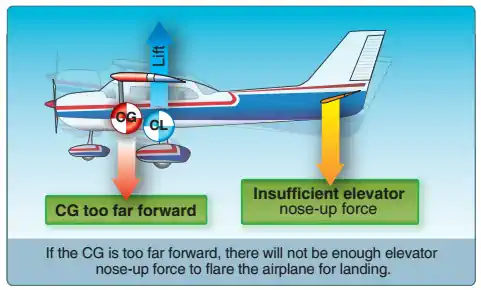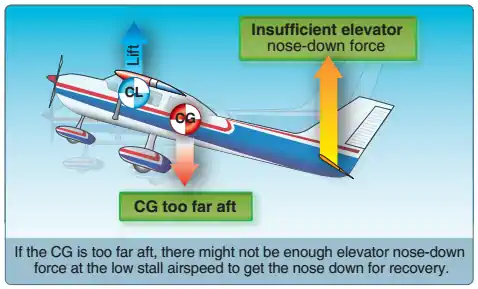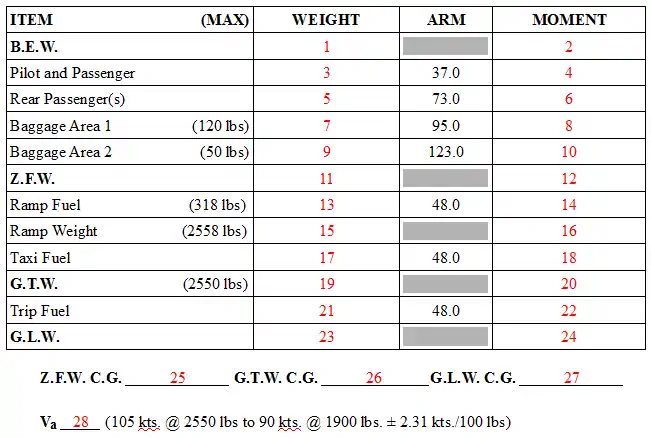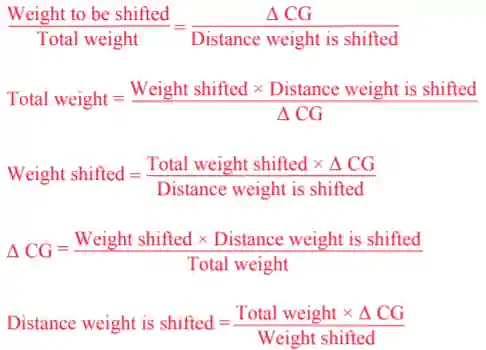Aircraft Weight & Balance
Weight and balance are critical factors not only in design but also in the performance and stability of an aircraft under various operating conditions.
Introduction to Weight & Balance
- Weight and balance are key factors not only in aircraft design but also in their performance and stability under various operating conditions.
- Weight and balance are both absolute (referring to the maximum load that the structure can support) and relative (distributed) in accordance with the design described in the aircraft's flight manual.
- The position of the center of gravity is affected by the total and the distribution of weight throughout the aircraft.
- Aircraft balance about their Center of Gravity (CG), whose location determines aircraft characteristics.
- Weight parameters ensure the wings and overall structure can support the aircraft throughout all flight envelopes.
- Before every flight, pilots must calculate the weight and balance to ensure the aircraft operates within manufacturer specifications.
- Weight and balance data is more than an exercise in determining where an aircraft's CG will fall.
- It is a safety concern that has resulted in the loss of several pilots and their passengers.
- Do you have a solid understanding of weight and balance? Don't miss the weight and balance quiz below and the topic summary.
Aircraft Weight
- Pilots and manufacturers express aircraft weights in several different ways:
-
Standard Empty Weight:
- The standard weight consists of the airframe, engines, and all items of operating equipment that have fixed, permanently installed locations in the airplane, including fixed ballast, hydraulic fluid, unusable fuel (fuel that cannot drain), and full engine oil.
- Standard empty weight refers to the weight of a standard aircraft, as it would be off the manufacturer's line, without any optional equipment.
-
Basic Empty Weight:
- The basic empty weight, or BEW, consists of the standard empty weight plus optional equipment.
- Consider any avionics upgrades or other installations the operator added to the airplane after manufacture.
- Weight and balance calculations begin with the basic empty weight, as this is the realistic minimum weight.
- The basic empty weight, or BEW, consists of the standard empty weight plus optional equipment.
-
Gross Landing Weight:
- Takeoff weight minus the fuel burned enroute.
-
Ramp Weight:
- The ramp weight is the weight of the airplane loaded for flight before engine start.
- The maximum ramp weight is the maximum aircraft weight for ground operations, ensuring the structure can handle the relatively static forces experienced during these operations.
-
Payload:
- Payload is the weight of only the passengers, baggage, and cargo.
- Essentially, the weight of the people and items you want to move, excluding the fuel required to do it.
-
Zero Fuel Weight:
- The Zero Fuel Weight, or ZFW, is the weight of the aircraft before the addition of fuel.
- The ZFW is the weight of the basic empty weight and payload, meaning the remaining permitted weight after subtracting the basic empty weight and payload is what remains for fuel.
-
Gross Takeoff Weight:
- The weight of the airplane just before brake release to begin the takeoff roll.
-
Useful Load:
- The useful load is the payload plus the fuel required for operation.
- Useful load equals the difference between the maximum takeoff/maximum ramp weight and the basic empty weight-in other words, how much you can add to the basic empty weight before exceeding the aircraft's weight limits.
-
Maximum Ramp Weight:
- Maximum weight for ground operations.
-
Maximum Takeoff Weight:
- Maximum weight for takeoff.
-
Maximum Landing Weight:
- The maximum weight is the maximum weight an aircraft can land with without overstressing its landing gear or airframe.
-
-
Overweight Aircraft:
- Most aircraft will never be too light to fly; however, overweight aircraft pose severe safety threats.
- People like R&B singer Aaliyah have died when pilots neglect to complete a proper preflight.
- Limitations:
- Longer takeoff run.
- Higher takeoff speed.
- Reduced angle and rate of climb.
- Reduced cruising speed.
- Shorter range.
- Higher stalling speed.
- Longer landing roll.
- Weight is a fundamental concept, but it is the distribution of that weight that is most critical to aviation operations.
- Pilots consider the Center of Gravity (CG), discussed below, to be the point at which all the aircraft's weight concentrates.
-
Multiengine Airplane Weight Considerations:
- Some multiengine airplanes have a ramp weight, which is in excess of the maximum takeoff weight.
- The ramp weight allows for fuel that would be burned during taxi and run-up, permitting a takeoff at full maximum takeoff weight.
- The airplane should weigh no more than maximum takeoff weight at the beginning of the takeoff roll.
- A maximum landing weight is a limitation against landing at a weight in excess of the published value.
- This requires preflight planning of fuel burn to ensure that the airplane weight upon arrival at destination is at or below the maximum landing weight.
- In the event of an emergency requiring an immediate landing, the pilot should recognize that the structural margins designed into the airplane are not fully available when over landing weight.
- An overweight landing inspection may be advisable—the service manual or manufacturer should be consulted.
- Some multiengine airplanes have a ramp weight, which is in excess of the maximum takeoff weight.
Weight and Balance Certificate
-
Weight & Balance Certficate Location:
- The weight & balance data is required to be in the aircraft at all times.
-
Weight & Balance Certificate Validity:
- Weight & balance data is valid for as long as the parameters do not change.
- The Center of Gravity is the specific point where the aircraft's mass or weight is said to be centered; that is, a point around which, if the aircraft could be suspended or balanced, the aircraft would remain in place at any attitude.
- It is computed during the initial design and construction phases, further influenced by the installation of onboard equipment, aircraft loading, and other factors.
- CG is of considerable importance in an aircraft, as its position (within a designed range) significantly affects longitudinal stability.
-
Location of the Center of Gravity:
- The CG must always be within limits; however, where specifically the CG falls within the allowable range will affect performance. [Figure 1]
-
Forward Center of Gravity:
- Stable feeling.
- Nose Heavy. (favorable stall characteristics)
- Longer takeoff distance (more airflow required to provide more force to lift a heavy nose).
- Increased induced drag.
- High stall speeds (requiring more airflow deflection of the elevator to maintain altitude at slower airspeeds) result in high Angles of Attack (AoA). [Figure 2]
-
Rearward/Aft Center of Gravity:
- As the CG moves rearward (toward the tail), the arm between the center of gravity and the tail (downforce) decreases; thus, the aircraft becomes increasingly dynamically unstable. [Figure 3]
- The tail will feel heavy, requiring additional nose-down force to compensate.
- Should the aircraft stall or spin, it will be much more difficult, if not impossible, to recover.
- Decreased induced drag.
- Lower stall speeds.
- Higher true airspeed due to a lower angle of attack.
- Longitudinal stability decreases.
- Performance impacts are due to changes in lift and drag.
-
- The CG must always be within limits; however, where specifically the CG falls within the allowable range will affect performance. [Figure 1]
-
Tailwheel Center of Gravity Considerations:
- Tailwheel aircraft typically have centers of gravity located behind the pilot.
- As discussed, the aircraft rotates about the center of gravity.
- Suppose directional control is lost due to erratic inputs or poor technique, as airspeed decreases.
- In that case, reduced control surface effectiveness will cause the tail to swing to the side.
- This situation can cause a ground loop where the center of gravity takes over directional control from the pilot and the control surfaces.
-
Multiengine Airplane Center of Gravity Considerations:
- The flight characteristics of the multiengine airplane vary significantly with shifts of the center of gravity (CG) within the approved envelope.
- Forward CG limits are usually determined in certification by elevator/stabilator authority in the landing round out.
- Aft CG limits are determined by the minimum acceptable longitudinal stability.
- Some multiengine airplanes may require ballast to remain within CG limits under certain loading conditions.
- Several models require ballast in the aft baggage compartment with only a learner and instructor on board to avoid exceeding the forward CG limit.
- When passengers are seated in the aft-most seats of some models, ballast or baggage may be required in the nose baggage compartment to avoid exceeding the aft CG limit.
- Most multiengine airplanes have general loading recommendations in the weight and balance section of the AFM/POH.
- When ballast is added, it should be securely tied down, and it should not exceed the maximum allowable floor loading.
- Some airplanes make use of a special weight and balance plotter.
- It consists of several movable parts that can be adjusted over a plotting board on which the CG envelope is printed.
- The reverse side of the typical plotter contains general loading recommendations for the particular airplane.
- A pencil line plot can be made directly on the CG envelope imprinted on the working side of the plotting board. This plot can easily be erased and recalculated anew for each flight.
- This plotter is to be used only for the make and model airplane for which it was designed.
- The flight characteristics of the multiengine airplane vary significantly with shifts of the center of gravity (CG) within the approved envelope.
-
Center of Pressure:
- It is essential to understand that an aircraft's weight concentrates at the CG, and the aerodynamic forces of lift occur at the Center of Pressure (CP).
- When the CG is forward of the CP, there is a natural tendency for the aircraft to pitch its nose down.
- If the CP is forward of the CG, a nose-up pitching moment is created.
- Therefore, designers fix the aft limit of the CG forward of the CP for the corresponding flight speed to retain flight equilibrium.
- Federal Aviation Regulation 21.5 establishes the requirement for manufacturers to provide weight and balance data ("operating limitations and information") to the pilot.
- The presented data are under the conditions under which the airplane or rotorcraft was type-certificated.
- The weight and balance information falls under "operating limitations" and is a required document in determining legal airworthiness.
- General data is in Section 6 of the Pilot Operating Handbook.
- Pilots measure weight and balance against a reference datum, an imaginary vertical plane from which they measure all horizontal distances (firewall, leading edge, etc.).
- From that datum, an arm, which is the distance from the datum, can be measured.
- Taking a known weight and multiplying it by the arm gives a pilot what they care about, and that is the moment or measurement of the tendency of the weight to cause rotation at the fulcrum.
- Weight and balance specifics vary by aircraft.
- Pilot Operating Handbooks (POHs) include weight and balance examples.
- Many pilots, however, will learn and therefore be able to relate to the Cessna 172: [Figure 4]
- Block 1: Determine the Basic Empty Weight of the airplane (found in POH).
- Block 2: Determine the basic empty weight moment of the airplane (found in POH).
- Block 3: Determine the weight of the pilot and passenger.
- Block 4: Determine the moment of the pilot and passenger (weight x arm = moment).
- Block 5: Determine the weight of the rear passengers.
- Block 6: Determine the moment of the rear passengers (weight x arm = moment).
- Block 7: Determine the weight of the baggage.
- Block 8: Determine the moment of the baggage (weight x arm = moment).
- Block 9: Determine the weight of the baggage as in step 7.
- Block 10: Determine the moment of the baggage as in step 8, using the new arm.
- Block 11: Add all weights together to get the Zero Fuel Weight (ZFW).
- Block 12: Add all moments together.
- Block 13: Determine the weight of the ramp fuel.
- Block 14: Determine the moment of the ramp fuel (weight x arm = moment).
- Block 15: Determine the ramp weight (ZFW + Ramp Fuel).
- Block 16: Determine the ramp moment (ZFW moment + Ramp Fuel moment).
- Block 17: Subtract taxi fuel used (~8 lbs).
- Block 18: Subtract taxi fuel moment (~384).
- Block 19: Add ZFW and Ramp Weight together, then subtract Taxi Fuel to get the Gross Takeoff Weight (G.T.W.).
- Block 20: Add ZFW moment and Ramp Weight moment together, then subtract Taxi Fuel moment.
- Block 21: Estimate trip fuel weight.
- Block 22: Determine the moment of the trip fuel (weight x arm = moment).
- Block 23: Subtract trip fuel weight from G.T.W. to get the Gross Landing Weight.
- Block 24: Subtract trip fuel moment from G.T.W. moment.
- Block 25: Divide block 12 by block 11.
- Block 26: Divide block 20 by block 19.
- Block 27: Divide block 24 by block 23.
- Block 28: Determine maneuvering speed (Va).
- Instructions found on the performance calculations page.
-
Weight Shift Formula:
- If you shift weight after determining the aircraft's weight and balance, then verify your calculations with the weight shift formula. [Figure 5]
- Pilots may make minor configuration changes to their aircraft, such as removing aircraft seats, as part of preventative maintenance.
- In addition to conducting a flight-specific weight and balance calculation/verification, pilots must account for minor changes by logging the maintenance in the aircraft's logbook.
- National Transportation Safety Board Identification (NTSB): ANC13FA091:
- The NTSB determines the probable cause(s) of this accident to be: The pilot's improper decision to load the airplane beyond its allowable takeoff weight and center of gravity limits, which resulted in a loss of control during the initial climb. Contributing to the accident were the external load and the downwind takeoff.
- National Transportation Safety Board Identification: ERA14LA450:
- The NTSB determines the probable cause(s) of this accident as follows: The pilot's inadequate preflight planning, which resulted in a takeoff with the airplane's center of gravity aft of its limit and led the aircraft to exceed its critical angle of attack and experience an aerodynamic stall during the initial climb. Contributing to the accident was the pilot's limited flight experience in the specific aircraft make and model.
- National Transportation Safety Board Identification: ERA14CA408:
- The NTSB determines the probable cause(s) of this accident as follows: The pilot/owner/builder's improper weight and balance calculations, which rendered the airplane uncontrollable in the pitch axis.
- National Transportation Safety Board identification: ERA14FA343:
- The NTSB determines the probable cause(s) of this accident as follows: The pilot's failure to secure the cargo in the cargo compartment, which resulted in a weight shift that led to the center of gravity exceeding its aft limit during a go-around attempt and a subsequent aerodynamic stall. Also causal to the accident were the pilot's inadequate preflight inspection and his loading the airplane beyond the cargo compartment weight limit.
- National Transportation Safety Board Identification: CEN13IA563:
- The NTSB determines the probable cause(s) of this accident as follows: The pilot's improper weight and balance calculations, which resulted in the airplane exceeding its weight and center-of-gravity limits and led to a loss of pitch control during takeoff, and the operator's failure to obtain required weight information and to ensure the aircraft was loaded correctly.
- Understanding weight and balance enables us to identify the relationships between an aircraft's weight and how its distribution affects performance and handling characteristics.
- Aside from the weight and balance data required to be carried on board the aircraft for determining its legality to fly, pilots do not need to complete a weight and balance calculation before every flight.
- Pilots should not allow the lack of regulation to lead to complacency.
- It is directed in part 91.103 that "Each pilot in command shall, before beginning a flight, become familiar with all available information concerning that flight."
- It goes on to specify "information appropriate to the aircraft, relating to aircraft performance under expected values of airport elevation and runway slope, aircraft's gross weight, and wind and temperature."
- Some aircraft may have a maximum takeoff weight that exceeds the maximum landing weight, meaning that landing immediately after takeoff would stress the landing gear.
- Weight and balance are directly related to the stability of the aircraft.
- Exceeding weight and balance limitations voids any assurance of the aircraft's ability to perform in flight.
- Instructions and examples can be found in the aircraft manual, under Section 6, for your specific aircraft.
- A few other terms which pilots may come across include:
- Loading Graph: used to find the moment for loads in the airplane.
- Center of Gravity Moment Envelope: shows limits with proposed loading.
- Still looking for something? Continue searching:
- Bold Method - What Effect Can and Does CG Have on Your Airplane Performance.
- Federal Aviation Administration - Aircraft Weight and Balance Handbook.
- Federal Aviation Regulations (21.5) Airplane or Rotorcraft Flight Manual.
- Federal Aviation Administration - Instrument Flying Handbook.
- Federal Aviation Administration - Pilot/Controller Glossary.
- National Transportation Safety Board.
- National Transportation Safety Board Safety Alert (SA-072) Minding Weight and Balance.
- PilotWorkShop.com - Weight & Balance Regulations.




